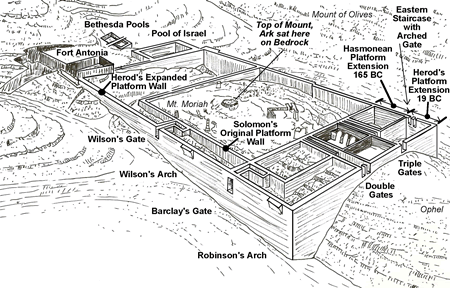
click for larger image |
David purchased the threshing floor north of the City of David from Araunah the Jebusite for 50 shekels of silver. This became Solomon’s Temple Mount
In recent Israelil-Palestinian conflict some Palestinians claim there was never an Israelite Temple on the Temple Mount (page 1). |
 |
Quote from page 3: “Yassar Arafat told the American negotiator Dennis Ross, and others, that even if Herod’s Temple did exist, it was not inJerusalem, but in Nablus, a city about 30 miles north of Jerusalem. Arafat was referring to the Samaritan Temple on Mt. Gerizim (in Nablus).” Arafat admitted to President Clinton at Camp David that his faith forbade him from recognizing the existence of the Jewish Temple saying, ‘I am a religious man and will not allow it to be written of me [in history] that I have . . . confirmed the existence of the so-called temple underneath the mountain.”
But Arafat did admit the existence of Herod’s Temple when he said: “The Jews have no claim to the whole area of the Haram al-Sharif. They [the Israelis} excavated everywhere and they didn’t find a single stone from the Temple [of Solomon], just some stones from the Temple of Herod.”(quote from p.3) |
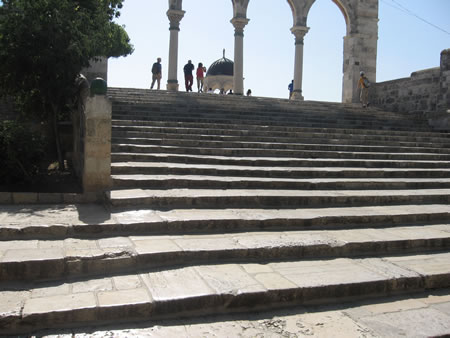 |
The Temple Mount is known in Jewish tradition as “Beth Yahweh” or “House of Yahweh” which is God’s dwelling place on earth.
According to tradition, Adam is buried on the Temple Mount (p 1-2)
There is not a single stone the can be said is absolutely left from Solomon’s temple (p. 2) |
The Time Between 70 AD and 638 AD
When the Muslims conquered Jerusalem in 638 there were no buildings on the Temple Mount to destroy. The Christians had left the Temple Mount in ruins, and even used it as a garbage dump.
The temple was destroyed in 70 AD by the Romans.
In 132-135 AD after the Jew’s second revolt against Rome the Jews may have attempted to rebuild the Temple.
In 135 Hadrian built a temple to Jupiter on the Temple Mount along with two statues of Roman emperors.
In 363 the Roman emperor Julian the Apostate gave the Jews permission to rebuild their temple. He did this to spite the Christians. The Jews did not get far since Julian died in battle verse the Persians in battle that same year. Ammianus Marcellinus, a friend of Julian wrote,
“Julian thought to rebuild at an extravagant expense the proud Temple once at Jerusalem, and committed this task to Alypius of Antioch. Alypius set vigorously to work, and was seconded by the governor of the province; when fearful balls of fire, breaking out near the foundations, continued their attacks, till the workmen, after repeated scorching, could approach no more: and he gave up the attempt.”
The earthquake in Galilee 363, sabotage, an accidental fire or the lack of Jewish commitment to the project may have been the cause along with the possibility of Divine intervention.
From 363 until 638 there was some building activity on the Temple Mount under the rulership of Christian emperors of Rome and Byzantine. (See details in this article by The Middle East Quarterly HERE.)
Roman Destruction of 70 AD
The soldiers of the Tenth Roman Legion (Leg X were stationed in Jerusalem for the next 200 years) completely destroyed and removed the Temple itself, but found it too difficult to dismantle the massive stone wall enclosing the Temple Mount.
Herodian Ashlars – rectangular blocks of dressed stone with slightly raised bosses in the center creatinga simpl, beautifully smooth surface
They were reused in:
- Omayyad palaces south of the Temple Mount – which is still visible
- Foundation of the Holy Sepulcher – When the Holy Sepulcher was identified by local Christians according to tradition for Helena in 325 the tomb was inside the city walls. If they had not really known they would have identified some location outside the walls, but since they identified a location inside the walls of 325 it appears they were holding to a very early tradition based on accurate information.
- An early Judeo-Christian synagogue on Mount Zion that is mistakenly called David’s Tomb but it is really the cenotaph of David (Cenotaph means a place of memorial without the remains of the person). It was called this because in the 1100’s it was believed the original city of David was on the western hill since it is higher than the eastern hill. The Bible says David was buried in the City of David. Archaeologist of the 1800’s correctly identified that the original city was on the eastern hill. This means that tradition based on inaccurate information was the reason for identifying this as David’s tomb
|
|
 |
Jewish, Christian and Muslim traditionally believe that Solomon built his temple on the Temple Mount |
When the Muslims took the city of Jerusalem from the Christians (Byzantine) in 638 AD the Caliph Omar was given a tour of the city by the patriarch of Jerusalem, a Christian monk named Sophronius. Omar wanted to see the spot where the Jewish Temple had been. The Christians for six centuries had left the Temple Mount lie in ruins, in fact, they used it as a garbage dump in order to fulfill Jesus’ words “there will not be left here one stone upon another that will not be thrown down.” (Matthew 24:2) For the first 30 years (638-691) of Muslim rule in Jerusalem a simple wooden sanctuary was built south of the Jewish Temple and around 660 a house of prayer was built on the Temple Mount “at the blessed site where the Temple stood”. According to the writings of Arculf, a Christian visitor to Jerusalem from 679-688, the Muslims had “built an oblong house of prayer, which they pieced together with upright planks and large beams over some ruins” at “that famous place where once there stood the magnificent Temple.” In the mind of the early Muslims the buildings on the Temple Mount, or the Haram, are the restoration of the Jewish site. The Dome of the Rock was the Muslim version of the Temple restored. It competed with the Church of the Holy Sepulcher in Jerusalem and with the shrines of the internal Muslim political opponents in Mecca and Medina. |
|
| |
|
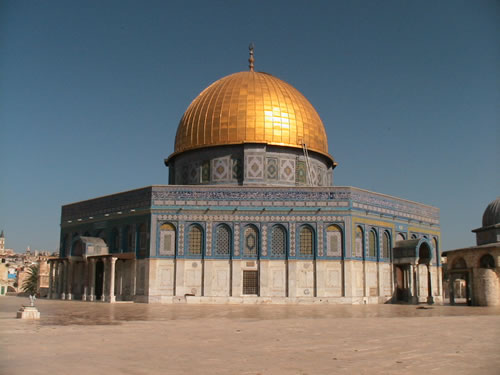 |
Dome of the Rock
Also called Qubbat Al-Sakhra
It was built 1300 years old. The Dome of the Rock was built in 691-692 and was designed to be a visual rival of the Church of the Holy Sepelchur which was the religious focus of the city when the Arabs conquered Jerusalem in 638.
Gold Dome is 65 feet in diameter
Built by ‘Abd al-Malik
Octagonal and covered with black, red and cream colored marble inlays while glazed tiles of royal blue, white, yellow and green cover the upper portion of the walls. There are long quotes from the Koran written all around the outside of the building.
The inside glimmers with polished marble, stained-glass windows, golden mosaics and woodwork. Two series of arches supported by columns called arcades enclose the rock mass that is the top of the original Mount Moriah in the center. |
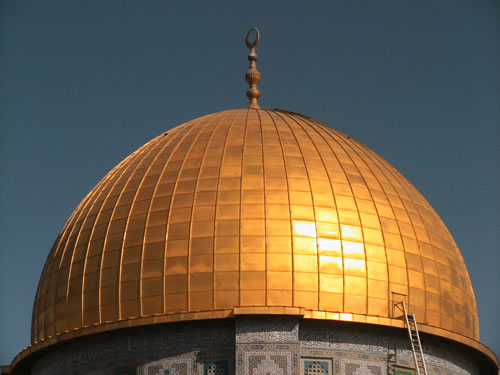 |
Inside the Dome of the Rock is an inscription in Arabic script from 691-692 that runs almost 800 feet in a narrow path around the octagonal walls as a form of Islamic artwork that reads: “O you People of the Book, overstep not bounds in your religion, and of God speak only the truth. The Messiah, Jesus, son of Mary, is only an apostle of God, and his Word which he conveyed unto Mary, and a Spirit proceeding from him. Believe therefore in God and his apostles, and say not Three. It will be better for you. God is only one God. Far be it from his glory that he should have a son.”
The reason the Dome of the Rock was built on the location where it sits today:
Some say it was from this rock that Muhammed ascended to heaven on a horse with the angel Gabriel. But, this is a 12th century tradition developed from a dream that involved Muhammed’s night journey in the Koran in Sura 17:1: “Most glorified is the One who summoned His servant (Muhammad) during the night, from the Sacred Masjid (of Mecca) to the farthest place of prostration, whose surroundings we have blessed, in order to show him some of our signs. He is the Hearer, the Seer.” But, Jerusalem is not mentioned here, nor is Jerusalem ever mentioned anywhere in the Koran. The Dome of the Rock was built 200 years before this tradition began to be told. back to the top |
 |
El Aqsa Mosque on the Temple Mount. It is the third most holy site in Islam.
In the bottom left of the photo is a stairway entrance leading down to the Double Gate in southern wall of the Temple Mount
Also built on the Temple Mount was the Al-Aqsa mosque. Just like the Dome of the Rock was built to overshadow the rotunda of the Holy Sepulcher, the Al-Aqsa mosque was built to imitate the basilica over calvary. The alignment of these two buildings complete the imitation of the Holy Sepulcher’s layout.
Today’s Al-Aqsa Mosque is quite a bit narrower than the orignal Al-Aqsa Mosque.
back to the top |
 |
The stairway in front of El-Aqsa that leads to the Double Gate in the Southern Wall.
Al-Aqsa mosque served as the palace of the Latin kings of Jerusalem during the days of Crusader occupation. It was given to the Order of the Knights Templar as a headquarters. Since Al-Aqsa mosque stands on the south of the Temple Mount the Crusaders considered it the remains of Solomon’s palace |
 |
El Kas, or The Cup, used for Muslim purification. It sits infront of El Aqsa and between the Dome of the Rock and the El Aqsa Mosque.
back to the top |
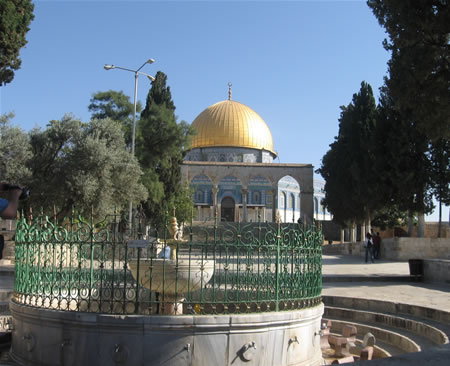 |
The Cup with the Dome in the back. |
 |
|
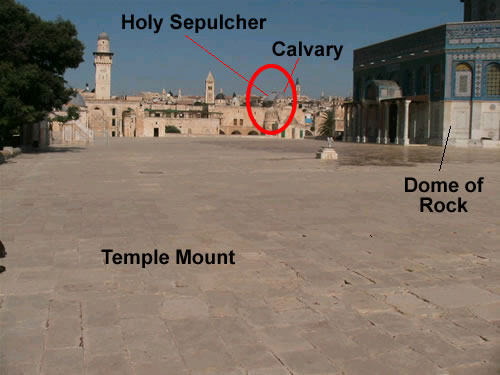 |
With the Dome of the Rock on the right side, the two grey domes of the Church of the Holy Sepelchur can be seen slightly to the left of the Dome of the Rock in the Jerusalem skyline.
The octagonal shape of the Dome of the Rock was the shape the early Christian’s used to encircle and enshrine important holy sites. The remains of an ancient octagonal church over the house of Peter in Capernaum is an example.
Since the days of the construction of the Dome of the Rock it has been understood by Muslims that the Dome of the Rock was to replace the Jewish Temple on the very site of the Jewish Temple built by Solomon, Zerubbabel and Herod.
back to the top |
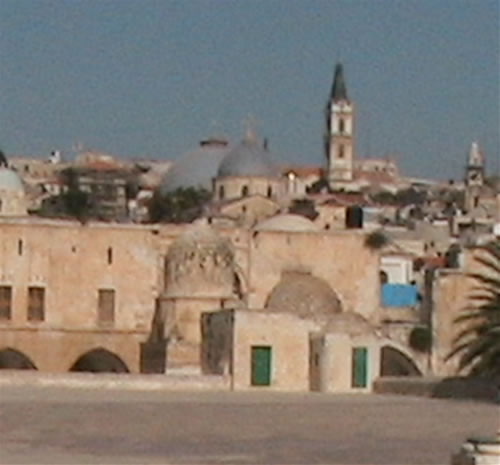 |
The Church of the Holy Sepelchur as seen from the Temple Mount. The small grey dome covers Calvary and the larger grey dome covers the grave of Jesus. The grey domes were copied by the builders of the Dome of the Rock and covered in a golden color to show visitors the superiority of Islam. The Dome was built over the site of the Jewish temple for the same reason.
The magnificent rotunda of the church of the Holy Sepulcher with its large dome that Constantine had built over the tomb of Christ declared Christ’s victory and his reign. Eusebius, the church historian from the days of Constantine, quoted Constantine as ordering a rotunda be built for Christ that was “of a magnificence worthy of his wealth and of his crown.”
The Dome of the rock was built 300 years later to rival this proclamation of Constantine and the Christian world.
When the Muslims took the city of Jerusalem in 638 they realized the importance and impressiveness the Church of the Holy Sepulcher had inside the city. The Holy Sepulcher had become the center of the city as is stated in the writings of a Christian pilgrim visiting Jerusalem in the 500’s.
The dome on the Muslim’s building on the Temple Mount is the same size as the dome on the Church of the Holy Sepulcher – 65 feet.
The Arab historian Muqaddasi wrote in 985, “is it not evident that ‘Abd al-Malik [builder of the Dome of the Rock], seeing the greatness of the martyrium of the Holy Sepulcher and its magnificence was moved lest it should dazzle the minds of the Muslims and hence erected above the Rock the dome which is now seen there?” |
 |
The Temple Mount pavement
Both Jewish and Muslim tradition says Mount Moriah is Eden. The book of Jubilees was written in the 100’s BC and was considered authoritative scripture by the Dead Sea community says, “The Garden of Eden was the Holy of Holies and the dwelling of the Lord.” (Jubilees 8:19) The inside of the Temple of Solomon was filled with engraved trees: “Around all the walls of the house he carved engraved figures of cherubim and palm trees and open flowers, in the inner and outer rooms.” (1 Kings 6:29) This is also the case for the inside of the Dome of the Rock which include mosaics of “repetitive trees, luxuriant foliage, bushes, jewels and floral motifs.” (page 23, “Jerusalem’s Temple Mount” by Hershel Shanks). Jewish and Muslim tradition states that the rivers of Eden flow below the Temple Mount. |
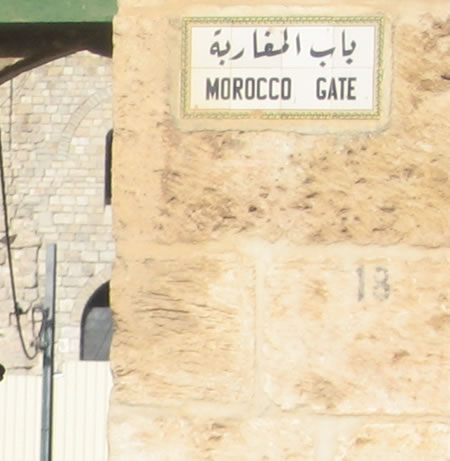 |
The Moroccans' Gate, Mugrabi Gate or Gate of the Moors, (Arabic: Bab al-Magharbeh; Hebrew: Shaar HaMughrabim), is located on the Western Wall. Barclay's Gate was covered over time as the ground outside the Temple Mount rose above the lintel of the gate. A new gate called Bab al-Magharbeh was installed in the Western Wall above the level of the Barclay Gate. The local residents of this area in Jerusalem at that time had come from Morocco so the gate was named for them. This gate remains open today. It is the only entrance to the Temple Mount for non-Muslims.
This photo is from the inside of the Morocco Gate on the Temple Mount.
back to the top |
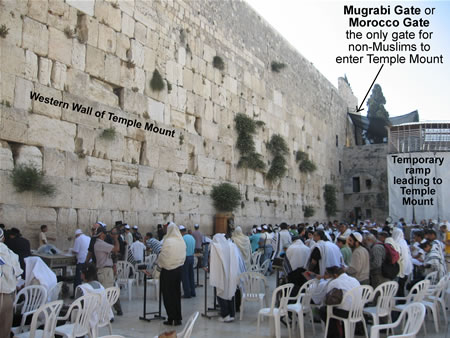 |
In 2007, after a landslide two years earlier made the earthen ramp leading to the Mugrabi Gate unsafe and in danger of collapse, the Israel Antiquities Authority started work on the construction of a temporary wooden pedestrian pathway to the Temple Mount. |
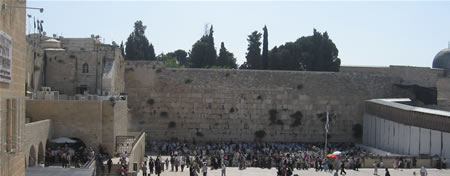 |
The ramp to the Mugrabi Gate (Morocco Gate) is to the right in this photo. Before the Jews excavated the Western Wall and removed the dirt build up over time the gate was at ground level. |
Other Temple Mount Gates that are open:
- Gate of the Tribes, Bab al-Asbat, NE corner.
- Gate of Remission, Bab al-Huttah, north side
- Gate of Darkness, Bab al-Atim, north side
- Gate of Bani Ghanim, Bab al-Ghawanima, NW corner
- Council Gate (Inspector's), Bab al-Nazer, west side
- Iron Gate, Bab al-Hadid), west side near "Little Western Wall"
- Cotton Merchant's Gate, Bab al- Qattanin, the Dome of the Rock can be viewed through this gate on the west side.
- Ablution Gate, Bab al-Matarah, west side.
- Tranquility Gate, Bab al-Salam, west side.
- Chain Gate, Bab al-Silsileh, west side and may to the Kiponos Gate from Herod's temple.
- Mugrabi Gate, BAb al-Magharbeh, west side and used by non-Muslims
These six gates of the Temple Mount are sealed closed:
- Golden Gate, Bab al-Zahabi, east side, built around 520 by Justinian I on top of the ruins of the original Eastern Gate
- Single Gate - on south side once led under the Temple Mount
- Huldah Gates (2 gates), Bab al-Thulathe, south side. The Huldah Gates are two sets of gates. One,The Double Gate, which is partially blocked by a Crusader tower used to lead to the Temple Mount. The second is The Triple Gate which also led to steps leading to the surface of the Temple Mount
- Barclay's Gate, is a gate from Herod's temple (the Coponius' Gate) located under the Magrabi Gate
- Warren's Gate, a gate from the time of Herod's temple that led to a stairway that led to the surface of the Temple Mount.
|
back to the top |
| |
|
|
Dome of Ascension (Qubbat al-Mi’raj) built outside the Dome of Rock to the NW on the same platform. It was built before the Crusaders and is mentioned in documents from 903 AD. The current Dome of Ascension was rebuilt in 1200 AD using Crusader material. This is claimed to be the place that Muhammad ascended from and is an earlier tradition than the claim he ascended from the rock in the Dome of the Rock.
The inscription above the columns inside the Dome of the Rock makes no mention of Muhammad ascending from the rock beneath nor does it mention the night journey of Sura 17:1
The Dome of the Rock was built over the rock that was the top of Mount Moriah (Moriah means “Yahweh is seen [here]”). This is also where Solomon built his temple according to 2 Chronicles 3:1, “Solomon began to build the House of the Lord in Jerusalem on Mount Moriah.” |
| |
|
The Temple Mount in 135 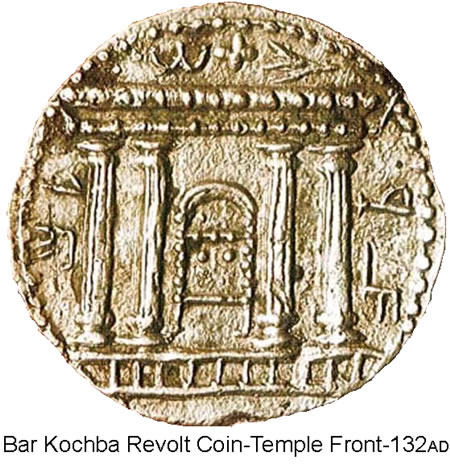
|
The Jews revolted against Rome in 132 and may have regained control of Jerusalem and began to rebuild their temple on the Temple Mount. Two ancient documents speak of Hadrain destroying the Jewish temple in Jerusalem. One is source is rabbinic material that writes of Hadrian’s destruction of the temple. A second is from a remaining portion of “Chronicon Paschale, a Christian chronicle which written about 630 AD that is an important source of information about the Byzantine Empire of that time and of earlier Jewish history. When Emperor Julian gave the Jews permission to rebuild the temple during his reign in 3___, he spoke of three previous destructions of the Jewish temple: Babylon in 586 BC, Rome under Titus in 70 AD and Hadrian in 135 AD. After the Second Jewish revolt of 132-135. One of the first things Bar K ochba did in 132 was to mint and issue a coin for the newly restored kingdom of Israel. The coin’s image included the front or façade of the new Temple in Jerusalem on one side and two silver trumpets used to call Israel to war from the Temple.
Hadrian followed the suppression of this revolt with the building of a temple to Jupiter on the Temple Mount and positioning a statue of himself on the temple mount. |
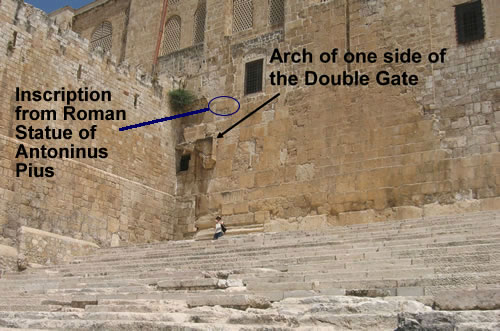 |
This photo is the southern double gate that led to a stairway that still exists on the other side of the wall that led worshippers to the Temple Mount. This wall contains a stone fragment from the base of a Roman statue from the Temple Mount dedicated to Hadrian's successor. |
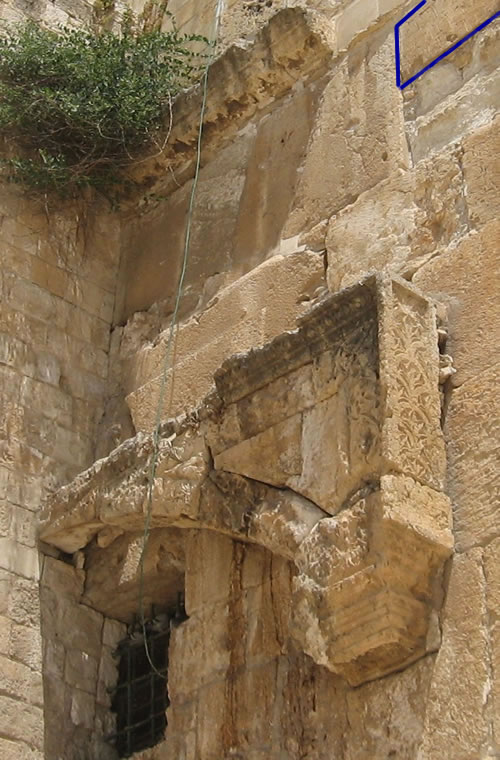 |
The very top stone in the very upper right corner of this photo is a piece of stone from the base of a statue of Antoninus Pius that stood on the temple mound (outlined in blue). The stone contains an inscription. Hadrian would have had the statue set on the temple mount along with the Temple of Jupiter that he built after his defeat of the Jews in 135 AD. |
Hadrian’s inscription reads:
TITO AEL HADRIANO
ANTONINO AUG PIO
P P PONTIF AUGUR
D D
Translation of Latin:
To Titus Ael[ius] Hadrianus
Antoninus Aug[ustus] Pius
the f[ather] of the f[atherland], pontif[ex], augur.
D[ecreed] by the D[ecurions] |
|
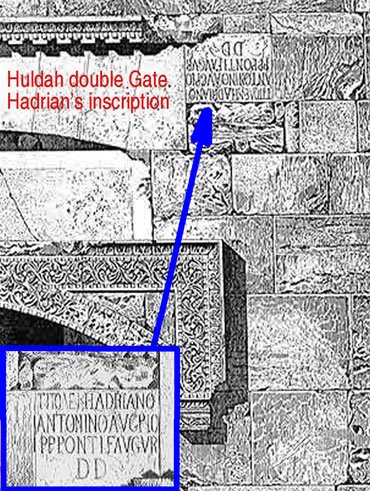 |
The block with the inscription from the statue has been reused and is placed in the southern wall of the Temple Mount upside down. |
The Roman Temple of Jupiter was torn down by Constantine. The stones were used later by the Muslims to build the Dome of the Rock and the Al-Aqsa Mosque. This inscription was found and placed upside down to replace a broken stone above this gate.
Hershel Shanks (archaeologist and editor of Biblical Archaeology Review) says:
"Hadrian erected an equestrian statue of himself on the Temple Mount. The anonymous fourth-century pilgrim known only as the Bordeaux Pilgrim reports that he saw two statues of Hadrian on the Temple Mount when he visited the site. The Bordeaux Pilgrim probably mistakenly identified the second statue; Hadrian's successor, Antonius Pius (138-161 AD), probably added an equestrian statue of himself, which the Bordeaux Pilgrim saw. . . It is quite possible the the Bordeaux Pilgrim saw this inscription when it was part of a statue on the Temple Mount. But he misread it. Antonius had been adopted by Hadrian and named as his successor in 138 A.D. Thus, Antoninus's name included the name of Hadrian. The Bordeaux Pilgrim apparently looked only at the first two lines and concluded that it was a second statue of Hadrian. Both had a thick beard and looked much alike when they were older. Some modern scholars have made the same mistake and read the same inscription now in secondary use as referring to Hadrian instead of Antoninus. They apparently focused on the name Hadrianus, ignoring the following name, Antoninus. |
|
| |
|
| |
|
| |
|
| |
|
|